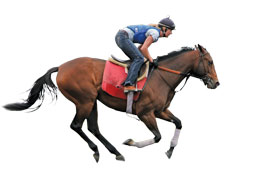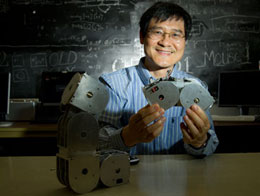Volume 28 · Number 4 · Summer 2011
News & Notes
A win for medicine
At 3:49 on a hazy afternoon, 12 horses lined up at the starting gate at Santa Anita Race Track. Among them was a former UC Davis patient, a Thoroughbred named Lukimbi, in his first race since recovering from a serious injury.
The starting bell sounded. Dirt flew. Lukimbi was running in the front of the pack. He inched his way forward with a steady, confident air. In the homestretch, he gained the lead and never let it go. He won by a head's length.

Lukimbi and rider in training
The February race marked an astonishing victory, not only for Lukimbi but also for the UC Davis veterinary regenerative medicine team whose work made his comeback possible.
Eighteen months earlier, Lukimbi had been diagnosed with a torn superficial digital flexor tendon in his right forelimb — an injury that typically would end a racing career. Today, stem cells are changing those odds.
"Our goal is to create real tendon tissue, instead of just creating more scar tissue, in the healing of tendons and ligaments," said Gregory Ferraro, '69, D.V.M. '71, director of the Center for Equine Health and founding father of the Veterinary Stem Cell Regenerative Medicine Group. "If left to natural processes, torn tendons heal by creating scar tissue, which is inelastic and does not fully integrate with the parent tissue. In other words, one ends up with a knot connecting two ends of a rope, instead of a reweaving of the rope's fibers to form a new rope, predisposing the tendon to additional injury."
Lukimbi received a total of four treatments, three to eight weeks apart, each with 10–20 million stem cells. After a three-month rehabilitation program at the Center for Equine Health, he went to the Circle Oak Ranch in Petaluma for conditioning on an underwater treadmill. Ultrasound exams during this period showed consistent improvement in fiber pattern in his injured tendon.
Lukimbi returned to Southern California to resume his racing career with trainer Paddy Gallagher. However, at Del Mar last summer, Gallagher noticed several times after workouts that Lukimbi's tendon felt warm, a potential sign of inflammation. So four months after his last stem cell treatment, Lukimbi received a "touch-up" dose at the racetrack.
Another ultrasound a few weeks later showed the tendon returning to normal size, with excellent fibers, and no sign of a previous injury.
Lukimbi has given scientists information that will advance tendon and ligament treatments — for both animals and humans.
In regenerative medicine, patients can be treated with their own cells (autologous cells), extracted from their own bone marrow or fat tissue, thereby avoiding rejection by the body. However, the culturing process to obtain the 10–20 million cells needed for each dose can take up to four weeks — too long for injuries that require immediate treatment.
So as part of ongoing studies to evaluate the safety of using allogeneic (nonself) stem cells, Lukimbi received cells that had been extracted from another horse's bone marrow, processed and then banked in the Regenerative Medicine Laboratory of the William R. Pritchard Veterinary Medical Teaching Hospital.
In Lukimbi, these cells did not evoke an immune response, even after multiple exposures. Clinical trials are currently being conducted in humans, so far with similar results.
Lukimbi also helped researchers better understand how stem cells move throughout the body, how many injected cells reach the targeted injury site and how long they remain there. The stem cells he received were labeled with iron oxide magnetic nanoparticles so they could be monitored via magnetic resonance imaging.
Stem cells have not yet been used to treat tendon and ligament injuries in humans, but could in the near future, according to Jan Nolta, director of the human Stem Cell Program and Institute for Regenerative Cures at the School of Medicine.
Ferraro said: "Lukimbi's story demonstrates not only the potential benefits of regenerative medicine but also how the collaborative efforts of human and veterinary medical researchers can truly help us move sports medicine forward."
Watch a video, Engineering for Stem Cells.
iMobot rolls, crawls and creeps

Professor Harry Cheng with robot modules
(Karin Higgins/UC Davis)
An intelligent, reconfigurable modular robot invented by a UC Davis alumnus and a professor of mechanical and aerospace engineering is headed for commercial development with the help of a grant from the National Science Foundation.
A single iMobot module has four controllable degrees of freedom, with two joints in the center section and two wheels, one on each end. An individual module can drive on its wheels, crawl like an inchworm, or raise one end of its body and pan around as a camera platform.
Graham Ryland, M.S. '09, and Professor Harry Cheng hope their "iMobot" will be a useful research and teaching tool. They also say the technology could be used in industrial applications, and may eventually form the basis of robots for search-and-rescue operations in difficult terrain. The university has filed a patent on the robot.
Ryland and Cheng developed the iMobot while Ryland was studying for his master's degree in mechanical engineering and conducting research in Cheng's Integration Engineering Laboratory.
Innovation hub: connecting the university to enterprise
The university is exploring ideas and concepts for an "Innovation Hub" that would better connect UC Davis research with entrepreneurs, accelerate the transfer of campus discoveries into commercial products and develop the regional economy.
The innovation hub could take many forms. It might involve creating virtual networks of existing resources, or building new space dedicated to fostering start-up companies — or all of those things, or something else entirely. At this stage, campus officials are reviewing 43 proposals, ideas and strategies from the community.
"The overarching goal is to help move university research into productive commercial use," said Karl Mohr, assistant vice chancellor in the Office of Administrative and Resource Management.
"We also want to explore matching that objective with local communities' economic development aspirations," he said.
University-driven prosperity
UC Davis, with annual research funding approaching $700 million, has secured more than 400 U.S. patents and earned $110 million in licensing revenue over the past 10 years. Now the campus is seeking to become an even more important force for innovation and economic development.
UC Davis is looking for concepts that mesh with local goals and that will help meet five objectives:
Advance the economic prosperity of the region and enable transfer of knowledge and technology from UC Davis to the marketplace.
Lead the development of the clean energy, life science and agriculture-based economy of Northern California.
Deepen connections to regional, national and global business communities.
Support a culture of entrepreneurship to transform UC Davis research into for-profit enterprises.
Provide educational opportunities for faculty, staff and students to develop and demonstrate the commercial value of their inventions.
Tokyo still at risk
Tokyo may be at serious risk from a massive aftershock and associated tsunami as a result of the devastating March earthquake near Sendai, Japan, according to seismologist John Rundle. Read the full news release, watch a video...
Better global health
A new initiative based at UC Davis will tap the power of sharing to deliver health solutions for the developing world. The Global Health Share Initiative aims to combine university discoveries, philanthropy, social entrepreneurs, investors and private companies to create profitable, affordable health care products in a socially responsible and culturally relevant way. Read the full news release...
Detection dogs influenced by handlers
The performance of drug- and explosives-sniffing dogs is affected by their human handlers' beliefs, a study by researchers at UC Davis has found. Read the full news release...
Experts urge water reform
California's water management system is deteriorating — on both economic and environmental fronts. Only a broad, integrative approach will reverse the decline, according to a new book by experts from UC Davis, the Public Policy Institute of California, UC Riverside, UC Hastings College of the Law and Stanford University. Read the full news release...
Surprisingly few white sharks
In the first census of its kind, research led by UC Davis and Stanford University found that there are far fewer white sharks off central California than biologists had thought. Read the full news release, watch a video...
Armenian genocide sparked humanitarianism
One of the 20th century's most infamous atrocities, the Armenian genocide, fostered the modern humanitarian movement, a UC Davis historian argues in a paper recently published in the American Historical Review. Read the full news release...
